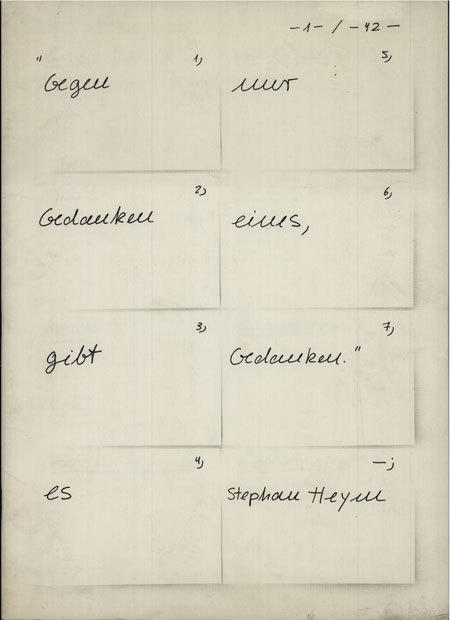

|
 historical historical
 ubuweb ubuweb
|
Hanne Darboven | Germany (1941-2009) 
 Schreibzeit 75/80 (1980) [PDF, 70mb] Schreibzeit 75/80 (1980) [PDF, 70mb]
""Hanne Darboven: Schreibzeit 75/80," InK, Halle für internationale neue Kunst, Zurich, 13 January-17 February Exhibition catalogue published in conjunction with show held January 13 - February 17, 1980. Features black-and-white reproductions of the artist's daily writings / drawings. * exhibition catalogue * wrappers * offset-printed * staple bound * black-and-white * [unpaginated] * edition size unknown * unsigned and unnumbered * ISBN 37192006X Hanne Darboven grew up in Rönneburg, a southern suburb of Hamburg, as the second of three daughters of Cäsar Darboven and Kirsten Darboven. Her father was a well-to-do businessman in Hamburg. Following a brief episode as a pianist, Darboven studied art with Willem Grimm, Theo Garve and Almir Mavignier at the Hamburg Hochschule für bildende Künste from 1962 to 1965. From 1966 to 1968 she lived in New York City, at first in total isolation from the New York art scene. In the winter of 1966/67 she met Sol LeWitt, Carl Andre, and Joseph Kosuth, representatives of Minimal Art. Soon afterwards her first series of drawings on milimeter paper with lists of numbers, which resulted from complicated additions or multiplications with calendar dates, hours and days of the week. The ‘daily arithmetic’ consisting of checksums came to replace the year’s calendrical progression according to a complex and challenging mathematical logic. Her paperwork comprised rows and rows of ascending and descending numbers, u-shapes, grids, line-notations and boxes. Employing this neutral language of numbers and using pen, pencil, the typewriter, and graph paper as materials, she began to make simple linear constructions of numbers that she called Konstruktionen. Similar to On Kawara, Darboven offers a system to represent time as both the continuous flux of life and clear embracing order. Along with LeWitt and Andre, Lucy Lippard and Kasper König belonged to the long-standing promoters of Darboven's work. In the 1970s Darboven often allied her work, which she considered a form of writing, to the accomplishments of writers such as Heinrich Heine and Jean-Paul Sartre, directly transcribing portions of their texts or translating them into patterns. By 1978 she was also incorporating visual documents, such as photographic images and assorted objects that she found, purchased, or received as gifts. Also that year, she first conceived her first large scale installations. An example for Darboven's work during this period is Sunrise / Sunset, New York, NYC, today. The work has been made in 1984 and consists of 385 drawings of felt pen on graph paper. The size is 31 x 35 cm each. The first drawing of each month is decorated with a nostalgical postcard showing prominent spots and picturesque scenes of past New York. The first drawing of each month is titled heute ("today"). All other days of the month are numbered consecutively. The total work is hung in monthly blocks of 30 or 31 day-drawings additional to the introductory postcard-drawing. All together the work represents a time period of living and working and at the same time evokes nostalgic memories of the past. In the 1980s she further expanded her scope by including musical arrangements and photographs in her displays. In her so-called “Mathematical Music”, she converted the numbers contained in her rows and columns into sounds. Numbers were assigned to certain notes, and numerical series translated into musical scores. With the aid of a collaborator, Darboven adapted them into performable compositions for organ, double bass, string quartet, and chamber orchestra. Hanne Darboven: ‘My systems are numeric concepts that work according to the laws of progression and/or reduction in the manner of a musical theme with variations.’ She died in Hamburg. -- Wiki RELATED RESOURCES:  Hanne Darboven in UbuWeb Sound Hanne Darboven in UbuWeb Sound
 Hanne Darboven in The UbuWeb Anthology of Conceptual Writing Hanne Darboven in The UbuWeb Anthology of Conceptual Writing
|